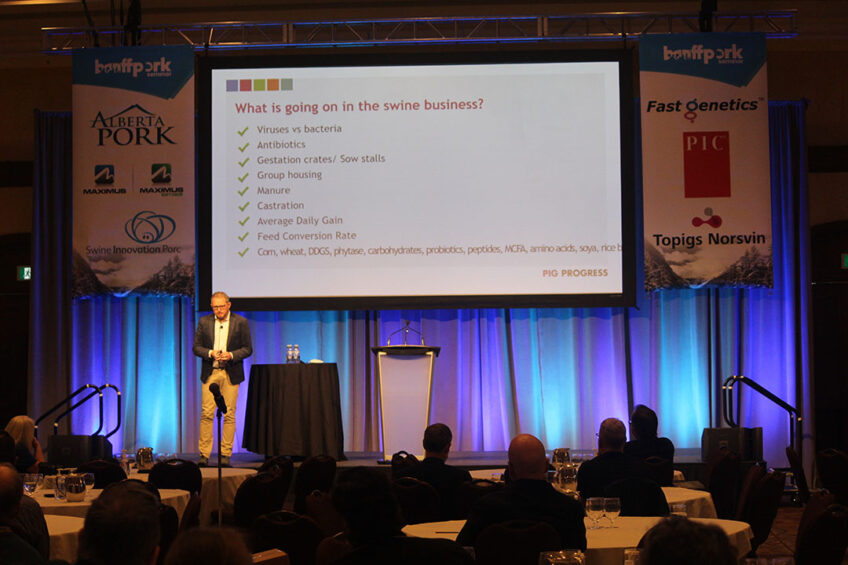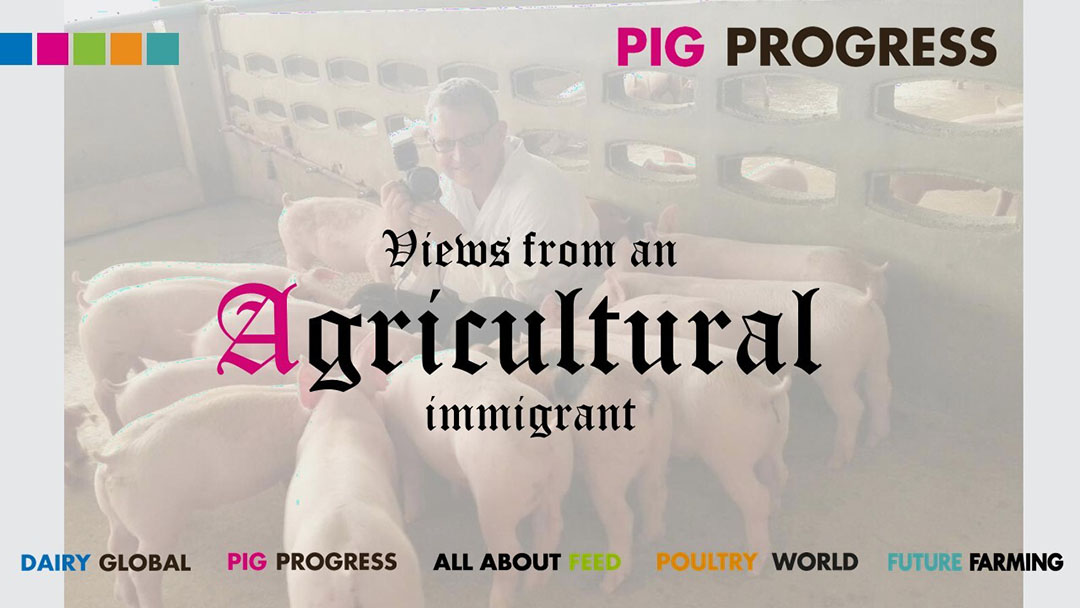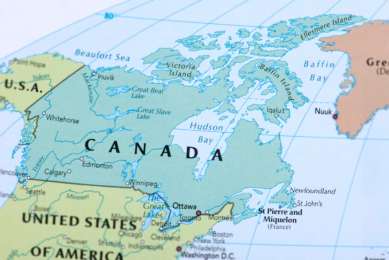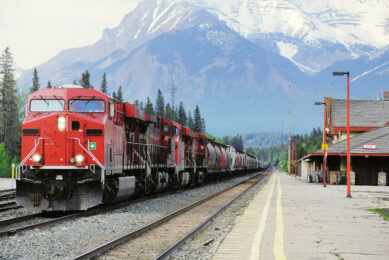An agricultural immigrant at Banff Pork Seminar (with video)

The kick-off of the international swine year traditionally takes place in Alberta, Canada, at the Banff Pork Seminar. Pig Progress editor Vincent ter Beek was invited to speak about his journey as an “immigrant” in the world of agriculture. Read (or view) his contribution to the seminar.
People often ask me why I ended up in the swine business. After all, in college I read History and Journalism – topics quite unrelated to animal husbandry. After obtaining my MA, I pursued my studies in the United Kingdom to do a post-graduate newspaper journalism course in English. I have been fascinated by the English language since I was young, so it sounded like a logical choice to make sure I could do my job not only in Dutch, but also in English.
Having worked for a while for 2 Dutch local dailies, I noticed an advert by publishing house of Pig Progress. They were looking for a native English speaker who was able to write journalistically and who knew his way around in the swine business. I may not be a native, but I manage well with my English, so I thought I might tick 2 out of 3 boxes. I decided to apply. I got an invitation and during the interview I admitted that I had no idea about the swine business other than I had been on a pig farm once. And that I would be happy to learn. It worked. A few days later I got that phone call.
Last December, that was 16 years ago.
FCR, sentinel pigs or Strep suis
Over these years I have grown completely accustomed to working in the world of Feed Conversion Rates, sentinel pigs, anti-nutritional factors, Streptococcus suis and Large Whites. Yet even though I know my way in the business pretty well, I have never felt a complete insider in the global swine industry.
I think one can compare it to being a geographical immigrant moving from the Netherlands to Canada. I could try and get accustomed to new culinary challenges, yet the food would not taste like it would back home. The command of language might be perfectly understandable, it may just sound a touch funny. Even though I would know how to sing O Canada, the only national anthem to really bring goosebumps would be the Dutch one. And although I would keep an open mind, I would always continue to prefer soccer over hockey.
The feeling of “coming home” in a pig house
This does not mean I have any negative sentiments towards the swine business – far from it – but I tend to view pig farms differently than some of the passionate visitors of the Banff Pork Seminar may do. I have spoken to pig farmers who have that feeling of “coming home” as soon as they step into a pig house. To me, a pig farm smells like a pig farm, and that is absolutely fine.
Similarly, I am not the most exciting dinner table guest when people start talking about feed prices the entire evening. At some point, I would start steering the conversation towards soccer, politics or – obviously – history.

It took me some time to realise that being the immigrant is the role that suits me perfectly as an international journalist. Had I grown up in agriculture, then I would not have been able to apply a professional distance, which I feel is also necessary from time to time to do my job well. It so happens that my Twitter timeline is a curious amalgam of people living in cities and working in journalism (often left-wing and sometimes vocal vegans), and people working in agriculture (complaining that many people in cities have lost touch with reality). I listen, and treat everyone with respect, but it is in my best interest not to choose sides.
Getting to know pig jargon on the way
It was a role that grew on me. In the beginning I tried to make sure that I would know every technical term like anybody else. When the people in the business were throwing around abbreviations, I wanted to know them all. C:F, ADG, MCFA, PRRS – I would have to nod and if somehow somebody would mention something I did not know, I would look it up immediately afterwards.
Getting to know my way into a new business, however, was a steep learning curve. I suppose that is the case with many businesses, and the swine business is no exception. I was clueless about various things. For instance, at that one-off visit to the pig farm I wrote about earlier, I asked the producer how many pigs he had on-site, to be able to say something about the size of the farm for a newspaper article.
The number of sows and piglets
In his response he murmured something about the number of sows and the number of piglets. I recall thinking: “Why is he talking about – how does he call them – sows? Surely I asked about the number of pigs… Skip the jargon, stop making things more difficult than necessary!”
It took a few years before I truly understood why the pig producer had been responding the way he had.
Similarly, before I started working for Pig Progress, I had no idea that it was common practice to castrate male pigs. Just one of the things that the entire swine business assumes is completely normal, so nobody even gives it a second thought that there are customers who simply do not have a clue. Ever since, I am convinced that if the industry would stop castrating overnight and not tell anyone, the feared outcry may not be half as big as expected.
Understanding the international swine production
Ever since, I have managed to get my head around many aspects of international swine production. I know my way around management, biosecurity, housing and equipment, breeding and the veterinary world. One of the fields that I struggle with is the world of animal nutrition.
Of all aspects of swine production, especially the nutritionist part I found a castle that is hardest to conquer. Obviously I know the basics, but there are so many ingredients, and parts of ingredients, additives, minerals, substitutes, classifications or nicknames of ingredients that oftentimes at international swine meetings, hitherto unknown nutritional terms get smoothly dropped without further introduction, followed by the next, and a next, plus a series of assumptions deemed logical to any member of the audience except me, topped up with for me unintelligible graphs and tables. I often find myself staring out of the window in despair, hoping the next speaker will have something more understandable to share.
And yes, that still happens fairly regularly after 16 years.
I hate to share it – but in the context of my presentation, this is relevant. Because I feel it might perhaps also say something about the swine industry. If a benevolent outsider, after 16 years, is not capable from time to time to grasp the message of what is being shared, then which conclusion to draw? Obviously, it means that I still have a lot to learn. But I think it also means – sorry to be blunt – that perhaps the swine business is a place full of in-crowd people, of specialists understanding each other but never really care about how outsiders may perceive the business.
The gap between agriculture and society
Let me now turn to the famous gap that the swine business often points to. City people have lost touch with agriculture, I regularly hear. The National Pork Producers Council in the USA stated that they wanted to “educate” the city people. They have lived away from agricultural reality for too long, they think milk is produced in a factory. They do not realise that for a pork chop, a sausage or spare ribs to be produced, a living creature has to be grown and slaughtered.
Now the logical question I have for the visitors of the Banff Pork Seminar is this: who is to blame for that gap between society and agriculture? And it is a rhetorical question as far as I am concerned. There is “blame” on both sides of the gap. I hope that the words I wrote a few paragraphs back can serve as an illustration that the swine business is not exactly super straightforward to get to know. On the contrary, it takes perseverance.
Swine business has developed strongly
And that is not surprising. Ever since the 1950s, the swine business everywhere in the world has been developing strongly. Rather than having multi-species farms, specialised farms were created everywhere. Some farms only do breeding, others only have finisher pigs. With farms fully equipped, in a safe remote place, and all the conditions met for perfect pig production.
Decent ventilation, a great lay-out, sophisticated feeding systems, state-of-the-art troughs, next-level biosecurity protocols, extremely high-tech feed formulation, well designed and differentiated roads in and out, properly protected by rows of fences to keep out unwanted visitors, whether they are of animal or human nature.
Outsiders and their perception of swine farms
Now what does that look like to outsiders? Imagine John and Anna are driving up all the way from Vancouver but alas, somewhere in Alberta their car broke down. They park at the roadside, and get out of their car.
“Do you smell what I smell? What is that?”
“I think it must be that building over there. I think they keep animals in there. Goats. Or cows or so.”
“I think it is pigs.”
“If you say so.” [Stares] “If they keep pigs over there, then why don’t we see then?”
“No idea. It certainly looks more like a prison with all that wire.”
It is a credible way a conversation can go. And yes, they could do with a bit of additional education. In the Netherlands, quite a few farms have therefore added a viewing gallery to their pig houses. Locals on bicycle tours – or people like John and Anna – are welcomed to step in, and take a look through the windows in a special guest corridor, and can see what is going on inside, together with signs explaining what is happening.
Showing everything there is to see on-farm
That is one step. But I think something else also needs to happen. For opening up to the outside world, and become more understood, it is also important to ask the question: does the swine business want to show everything that is happening on the farm? For that, I like to think of the Instagram test.
If a pig producer would want to be 100% transparent, share everything and “educate” followers, would he be able to share pictures of farrowing crates and get it explained in such a way that city people will understand and appreciate the fact that an animal cannot move for a month? And how about tail docking? Castration?
Painful questions to ask perhaps – and I would like to remind the readers I am not asking them for activist reasons. They are relevant because this will form the license to produce in the near future. We all know that by 2050 there will be over 9 billion mouths to feed. They may not all be eating meat, but if everyone at least has some money to spend the demand to meat will only grow. And where will these extra people of the future live? Most likely the vast majority will live in cities.
Scrutiny towards pig production will grow
Which means that the number of people detached from agriculture will exponentially rise. Which also means that the scrutiny towards production methods is also likely to grow. The Instagram test therefore is not hypothetical – for swine producers it holds the key to future production, because increasingly people will ask how their food was made.
In the European Union they are currently talking about getting rid of farrowing crates by 2027 – and I am convinced technology will find new answers to the old problems of overlaying and aggressive sows. Tail docking as well as castration are also practices which are being debated and even though at the moment no clear steps are being taken in terms of legislation, I have no doubt that these practices will disappear.
Ignoring the sounds of society
The swine business can of course choose to ignore these sounds, dismiss them as the next passer-by having dropped some idiot thoughts or go back to their day-to-day job. However, I am not a passer-by. As an agricultural immigrant, For the past 16 years, I have stood on the bridge spanning the gap between society and agriculture.
And today I have done what I was asked to – I shared my view from that bridge.
Banff Pork Seminar lasted from 11-13 January, 2022, with a hybrid attendance, of people attending both in-person as well as online. The article above has been reprinted with kind permission of the organisers of the seminar. The next edition of the event will take place in January 2023, in Banff, AL, Canada.











